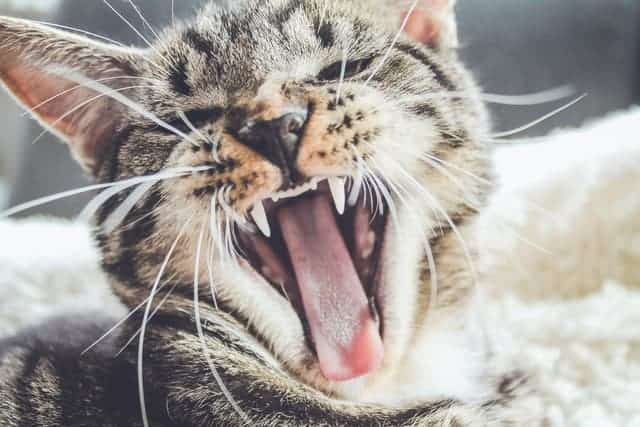
The tongue of a cat is a unique and peculiar muscle, which you cannot imagine all the uses it has, to greatly improve the daily life of your kitten.
Cats in general are quite curious little felines, to tell the truth, they have quite wonderful physical qualities that we can say that no other animal possesses.
And if you are not aware of how functional and curious a cat’s tongue turns out to be, through this post we will let you know its qualities, and discover how important it is for its health.
Why do cats have rough tongues?
If you have a cute pussycat as a pet, surely it has given you a lick at some point in your life and you have surely noticed that its tongue has a very characteristic texture.
It is much rougher.
When your cat licks you, you feel as if instead of having licked you, it had rubbed sandpaper over your skin. But why does it feel that way?
Well, the characteristic roughness and roughness of a cat’s tongue have a very simple explanation, and it is due to a set of minimal filaments, which fulfil the main function of taste buds, but in the form of spikes.
Yes, the tongues of cats have on it, right in the central area of it, somewhat sharp nuggets called conical papillae, and their main component is keratin.
Surely this component will sound familiar to you, and it is because this is also what nails are made of. And this is why the texture of a cat’s tongue is so rough.
In addition, this composition of the cat’s tongue provides it with many qualities necessary for its day-to-day life.
This characteristic tongue is essential in the cat to carry out vital tasks such as grooming, hydration, identification and feeding.
What functions does the tongue of cats have?
Without a doubt, the structure so characteristic of the tongue of cats is not by chance.
This in its entirety has several functions that turn out to be basic for the pussycat. Let’s see them:
Usefulness of the tongue when eating and drinking
One of the basic functions of a cat’s tongue is to facilitate the consumption of food and drink.
Let us first mention how this is very useful when the kitten is dedicated to hunting, it is not a secret for anyone that cats are a carnivorous animal species, and a natural predator, by nature .
The filaments that it has on its tongue allow the animal that they hunted to be trapped, well attached, and not have any opportunity to escape from the claws and mouth of a cat. In addition, with it they can scrape a little the bones and flesh of their victims .
Like many animals, cats use their tongues to help them drink liquids .
And although at first glance the task of drinking seems extremely easy for cats, it really is something much more complicated than it seems. Well, cats when drinking Defy gravity! Curious no?
Many species of animals such as dogs, to be able to consume liquids, introduce their tongue and bend it upwards, giving the necessary impulse for a jet of water to be able to enter their mouth.
But, cats don’t do it that way, they don’t use that common movement.
These, surprisingly, do the movement, but in reverse. Instead of bending their tongue up, cats do it down and then make a strong and quick push back, as if they wanted to roll it up.
It causes a jet of water to shoot towards its mouth, the water is trapped between the papillae and is then thrown into its mouth.
And this is how they manage to drink large amounts of liquids very quickly .
This drinking technique is a great skill that defies gravity.
Cats tongue to clean
The tongue, apart from being useful for feeding and hydrating, also helps cats to stay clean.
The tongue of cats has on it some keratin filaments that give it that curious rough texture.
These filaments known as conical papillae did not have a specific function, their purpose was a mystery.
However, recently, after meticulously studying and observing a group of cats made up of different species, the true function of these papillae was discovered:
And it is that in each of the papillae there is a small cavity that is responsible for collecting small amounts of saliva and then distributing it, by licking, through the cat’s fur.
We know well that cats, apart from sleeping a large part of the day, also spend a lot of time grooming themselves, licking themselves everywhere in order to get rid of fleas, traces of dirt, odours and to groom their fur.
And with their tongue they help each other a lot in this task, thanks to the pile of filaments with small cavities, which provide a rough touch to the tongue, and which trap all the unwanted organic debris.
These cavities located in the conical papillae, take on the task of storing saliva, which will later be deposited on the animal’s fur in a homogeneous way, which will clean it, and also refresh it . They are able to regulate their body temperature with this action.
It is like a bathroom in every way. The papillae have the ability to reach the cat’s own skin.
If the coat is very thick and dense, grooming will not be very complete, it will be much more difficult for them. This occurs in long-haired cat breeds.
Also with the help of the tongue and its pointed papillae it is also possible for the cat to remove dead or loose hair, and it will also untangle the fur.
As a curiosity, with the study that gave an answer to the function of the conical papillae, it was possible to manufacture a brush, with certain characteristics of the tongue of cats and that was a great success.
Stress out
Another function attributed to the tongue of cats is to relax them. And it is that cats not only lick to clean themselves or to groom themselves. They also do it with the intention of taking some stress off, with a relaxing intention.
So, if you observe your cat licking itself excessively, it is very likely that it is suffering from some stress. So if this happens, feel free to take it to a vet.
To say that they love you
That’s right, cats show their affection and closeness with a good lick .
It is not usually common in them, but if you are lucky that your cat runs its rough tongue over you, it means that it is cleaning you and that it considers you family.
Diseases in the tongue of cats

Cats can have a tongue condition at some point in their life . This may be a symptom of some other disease much more serious than a tongue infection such as a feline virus condition.
Cats can develop tongue ulcers that may or may not be painful as well as the main disease that causes them.
Now, we will tell you some of the causes of tongue infections:
- Some upper respiratory infection: a respiratory virus such as cat flu can cause ulcers or lesions on the cat’s tongue.
- Stomatitis: some variations of this condition can be the cause of some conditions in the cat’s tongue. Viral stomatitis is one of the variations that cause ulcers on the tip of your cat’s tongue. Another variation that produces lesions in the mouth would be thrush.
- Immune-deficient diseases: Cats with these types of diseases can get glossitis , which is a painful inflammation of the tongue. Although this infection can also develop due to a cut or scratch on the tongue.
- The pox virus : this virus generates skin lesions at first, it also affects your cat’s legs, head, neck and forehead. And during its development it also generates ulcers on the tip of the tongue.
- Some feline herpes viruses: such as Clamydophila, Mycoplasma and Bordetella, these can also cause ulcers on the tongue. Well, this is the end of the post, I hope you have learned how important it is, the language in cats , and how essential and necessary it is for your cat to have a good cat life.






